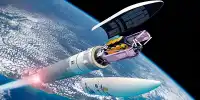The study of cosmic weather to determine the habitability of exoplanets and celestial bodies is an exciting and quickly evolving topic of study. Cosmic weather refers to a variety of factors such as star activity, radiation, magnetic fields, and other environmental conditions that can have a substantial impact on a planet’s viability for life.
A new study implies that once the next generation of massive, high-powered observatories comes online, their instruments may provide scientists with an unprecedented opportunity to determine what the weather would be like on distant exoplanets.
These observatories dubbed the Extremely Large Telescopes (ELTs), will include the Extremely Large Telescope (ELT), the Giant Magellan Telescope (GMT), and the Thirty Meter Telescope (TMT), and their instruments are expected to outperform the capabilities of the James Webb Space Telescope.
Data from their powerful instruments will allow astronomers to use Doppler Imaging – a technique that can recreate 2D maps of an object’s surface – to make accurate measurements of the magnetism and chemistry of ultracool targets, or cosmic objects with temperatures less than 2700 K, such as brown dwarfs (BDs) or very low-mass stars (VLMs) – and even some exoplanets.
Learning about the atmospheres of other objects outside our solar system not only informs us how Earth’s atmosphere may behave but allows scientists to scale those concepts to study potentially habitable planets.
Michael Plummer
The ability to study the chemical compositions of these objects more precisely not only helps to improve our understanding of some of the universe’s most mysterious objects, but it also provides greater insight into the search for life on other worlds, according to Michael Plummer, lead author of the study and a graduate student in astronomy at The Ohio State University.
“Learning about the atmospheres of other objects outside our solar system not only informs us how Earth’s atmosphere may behave but allows scientists to scale those concepts to study potentially habitable planets,” Plummer stated.
The study was published this month in The Astrophysical Journal.

Magnetism is particularly crucial in the hunt for worlds like our own because magnetic fields, particularly in smaller star systems, are thought to be necessary to support and impact whether a planet may host life on its surface.
Plummer and Ji Wang, co-author of the study and assistant professor of astronomy at Ohio State, previously developed a publicly available analytical code called Imber to simulate and infer the presence of surface discrepancies on distant objects such as magnetic star spots, cloud systems, and other atmospheric phenomena such as hurricanes.
They employed the technique in this study to evaluate the scientific capability of various ELTs’ sensors to detect surface fluctuations on six targets: Trappist-1, a well-studied seven-planet system about 40 light-years from Earth, two brown dwarfs, and three exoplanets.
The GMT’s Consortium Large Earth Finder (GMT/GCLEF), the ELT’s Mid-Infrared ELT Imager and Spectrograph (ELT/METIS), and the TMT’s Multi-Objective Diffraction-limited High-Resolution Infrared Spectrograph (MODHIS) were all employed to test their technique.
While discerning star spots on Trappist-1 was difficult for all three instruments due to its edge-on inclination – or its parallel orbit to the rest of the sky – ELT and TMT were able to make high-resolution observations of the brown dwarfs and exoplanets over a single rotation.
GMT’s equipment, on the other hand, needed numerous rounds of observations to determine the presence of surface abnormalities on the study’s chosen exoplanets. Overall, the study demonstrates that their technique can provide an accurate prediction of ELTs’ future capability and assist in determining whether future targets are worth investigating on a wider scale.
Plummer also stated that their strategy has piqued the curiosity of scientists attempting to identify or confirm planetary bodies discovered via the radial velocity method – a method of discovering exoplanets by measuring the minor gravitational effect an object has on the star it circles. In essence, their research is the first step toward assisting scientists in making the greatest use of future astronomical tools.
“The more we learn about other similar planets to Earth, the more those discoveries should inform Earth science itself,” Plummer stated. “Our work is particularly well-suited to help make those real-world observations.”














